SHAKUHACHI CD REVIEWS

SHAKUHACHI IN TRADITIONAL CONTEXTS
FURUYA TERUO, MATAMA KAZUSHI & KAKIZAKAI KAORU – Fudô. A review by Véronique Piron
Furuya Teruo, Matama Kazushi and Kakizakai Kaoru have had the desire to pass on their repertoire to the current and next generation through a long-time partnership with Watanabe Yutaka and his production company ‘Bamboo’, with whom they have re-edited in the last years some DVD’s on Yokoyama Katsuya’s teaching and Fukuda Randô’s music amongst others. This time, it is about the work of the generation of modern composers, from the 1960-1990’s, a period considered as the golden age of the shakuhachi.
This CD and that of Furuya-sensei’s solo album, ‘Ukigumo’, are presented in slim cases, quite simple and convenient, flexible and transparent, coming with a single reversed page as the jacket.
The piece
Fudô is a cycle of 5 pieces numbered from 1 to 5, which, for the first time, is edited in its entire set in a single CD, and which bears the title of the cycle. This is a magnificent initiative, and a wonderful opportunity to get an idea of this piece in its entirity. Composed between 1965 and 1987, they were initially not planned as a series. They were commissioned by Sanbon-kai, the trio made up of three of the major masters of the 20th century, Aoki Reibo, Yamamoto Hôzan and Yokoyama Katsuya, who assumed the role of innovators of new music at that time, for Fudô 1 and 5, by NHK for Fudô 2, and by Aoki Reibo himself for Fudô 3. Fudô 1-2- 3 were written at nearly the same times, while Fudô 4 and 5 were written about 10 years later. Each piece is approximately the same length, 11’15 (for F4) to 13’ (for F2), and this CD consists of a total of 60 minutes.
The composers’s spirit
Kineya Seihô, originally a nagauta-shamisen player, born in 1914, was a composer who wrote for traditional instruments and was particularly prolific for the shakuhachi which fascinated him, finding common points with its own instrument. With more than 30 works in his catalogue for shakuhachi, there are many solo pieces including Ginyû, Ryûro and Ichijo, which are the most often played, a duet for shakuhachi and shamisen, Meikyô, and other pieces. His compositions are often viewed in terms of their technical aspects, comparing the language of the two instruments, nagauta-shamisen and shakuhachi, and what they have in common. However, he is also a composer who was impressed by the post-world war years and who decided to combine music with human feelings, “to reveal a deep expression” in Ryûro, and “to express fluctuating feelings” in Ichijo, and to evoke poetic images connected to nature, a common point with all Japanese culture. It is, thus, unsurprising that we can imagine the three disciples of Yokoyama-sensei taking over this whole cycle, being well-trained by their very sensitive master and fervent advocate of the human commitment.
Kineya Seihô’s work
By listening to all these pieces, one after the other, we can see the characteristic language of the composer, with a certain simplicity and an efficiency, using melodies which remain in our memory long after listening to the whole CD. Kineya knew how to explore the basic language of the shakuhachi while staying in a very melodic context without being influenced by western music as much as his predecessors like Miyagi Michio (1894-1956) or Fukuda Randô (1906-1976), and without moving towards contemporary music, which is what he could easily have done as a next step and what the next generation of composers such as Makoto Moroi (1930-2013) did. The results then are rather classical compositions.
Fudô evokes the movement (動 dô) of the wind (風 fu), used as an image to illustrate the confusion of the human heart, or how nature and man can coexist together in harmony. Every piece is unique while the language is common to the five Fudô, written in a single movement, with tempi and dynamics changes indications which mark the various parts. The three voices are organized in a relatively identical way during the whole cycle, with basically two high 1.8 or 1.6 shakuhachi and one long 2.3 or 2.4 shakuhachi. They are used in a well-balanced way, the melody, counterpoint or accompaniment going alternately from one voice to the others. The composer also particularly likes the process of tiling (from the beginning in Fudô 1), and the division of the melody in short portions shared between the three shakuhachi (like in Fudô 4, with a feeling of bells ringing).
Kineya Seihô combines the traditional language with a more modern one. He remains rather faithful to the pentatonic style, even if sometimes he gives the illusion to modulate towards a heptatonic style, and occasionally uses chromaticism to bring some tension. He uses free rhythm, especially in the solo sequences that we can hear through all the five Fudô, with replies and echoes, and some veloce phrases. He uses metric rhythm; the doted ones which are reminiscent of the traditional odori-byoshi (rhythm of the dance) or swing, like the way the shamisen plectrum can produce repetitive cells, then backbeats and syncopes of a more modern character (all particularly used in Fudô 2).
The basic techniques of the shakuhachi are exploited here to evoke the wind, its images, its passage described with melodic lines moving, its prints, etc.; repeated strikes, koro-ne, simple and double appogiaturas, trill, muraiki, portamento and suri.
The interpretation
The CD starts with the first notes of Fudô 1, like a copy of the very start of the honkyoku Tamuke, to bring us immediately into the composer’s world. Our three musicians have shared the three voices in an equal way, by changing their place when playing the next Fudô piece. The whole series thus remains homogeneous, in the real spirit of chamber music, trying to reach one unique sound, ‘ichi-on’, when the music allows it, or the idea of ‘robuki’, such as they are used to practicing it, during meeting places in the music, for example in Fudô 1. Indeed, Furuya Teruo, Matama Kazushi and Kakizakai Kaoru have been working together for decades, at first under the direction of Yokoyama-sensei who was particularly attentive to the sound quality as that of a classical string trio. They tried over the years to find an ensemble sound in which each can merge, while keeping their own identities; expressive, forceful, quiet… I have been personally touched by some of their musical choices, such as the long accelerando of the central part in Fudo 3, incidentally already recorded with Furuya Teruo, Matama Kazushi and Yokoyama-sensei in 1995 on Shakuhachi, the art of Yokoyama Katsuya, as well as the generally quiet mood of the trio in full maturity.
This is a must-have CD in our collections.
We can imagine that we will have the opportunity to hear this trio playing one or other of these Fudô compositions, in front of us next month in Radolfzell, Germany during the European Shakuhachi Summer School, at which they are the main invited masters. It is for our very great pleasure.
Véronique Piron
Furuya Teruo, Matama Kazushi & Kakizakai Kaoru – 風動 Fudô (Kineya Seihô).
Mixed by Yutaka Watanabe at Music Inn Yamanakako, Japan
Bamboo, 2013 BCD-083
Track list:
1. 風動 – Fudo
2. 第二風動 – Fudo No. 2
3. 第三風動 – Fudo No. 3
4. 第四風動 – Fudo No. 4
5. 第五風動 – Fudo No. 5

FURUYA TERUO – Ukigumo. A review by Véronique Piron
It is with great happiness that we can review the release of this CD!
This is indeed the 3rd CD under Furuya Teruo’s own name, the other recordings having been made in the circle of Yokoyama Katsuya, with a first solo album in 1994, some 20 years ago.
As the title indicates, this recording is dedicated to koten honkyoku: Ukigumo, Yamagoe, Sanya (3 valleys), Sagariha, Azuma-jishi, Reibo, one honkyoku in the Kinko style, Hifumi-hachigaeshi, and two unusual pieces, Kuyônokyoku and Nanadan Tsuru-no-Sugomori.
The entire program is interpreted on a standard 1.8 shakuhachi. Whether it is by aesthetic choice or concerns regarding direct transmission, and even though it is the most practised instrument in a teaching situation, this represents a big challenge. How is it possible to mix pieces which are poles apart such as Azuma-Jishi, a light and short honkyoku usually played on a short shakuhachi, and Reibo, a deep and long honkyoku usually played on a long shakuhachi, using an instrument of a specific size? This asks for a total commitment and a deep rooted way of playing to be able to go beyond the only consideration of the size of the instrument.
Furuya Teruo has a personality of overflowing generosity, particularly sensitive to human feelings. His playing is an access into expression, with a full tone, close to the heart, or ‘kokoro’ in Japanese. It is with this in mind that he conceived his whole program, approaching this ancestral repertoire in its melodic aspect (uta, ‘song’, in the CD notes). Always in search of special dexterities or the ones most able to reproduce sounds which are going to touch the expression or the idea the closest, he starts this CD on the Ha-Ro pattern with Ukigumo in a sound ‘on a razor’s edge’ which catches our attention from the start.
This is the most mysterious piece of the repertoire passed on by Watazumi and Yokoyama-sensei (who, by the way, made only a very few recordings of it), and suggests to the performer to feel free, like the clouds floating above all the pains of the human soul, coming and leaving: Ukigumo ‘floating clouds’, which is also the title of this recording and a choice which fits marvellously with our performer’s personality.
What surprises by listening to all these honkyoku one after the other, is the richness of the whole set. Among others we can observe that each piece has a unique and recognizable start, although they are all played with a single flute and the whole repertoire contains many common sentences and identical patterns. In the middle of the CD are two unusual pieces; the very short, simple, melodic and calming Kuyônokyoku from Myoan Shinpo Ryû, and a version of Tsuru no Sugomori in 7 parts, nanadan, one of Furuya-sensei’s preferred themes, and thus we cannot be surprised that he provides us with a new, exciting version of it. These two pieces based on repetitive melodic patterns and cycles bring a kind of rhythmical breath. The whole CD is a performance of total mastery and demonstrates a full artistic maturity.
Furuya Teruo quotes at the beginning of the CD notes:
一音成仏, ichion jobutsu, ‘enlightment through one single sound’ As a conclusion, we could maybe say: 一管成仏, ichikan jobutsu, ‘enlightment through one single tube’.
Véronique Piron
Furuya Teruo – Ukigumo. Shakuhachi Koten Honkyoku Album n°1
Recorded and mixed by Yutaka Watanabe at Music Inn Yamanakako, Japan
Bamboo, 2014 BCD-085
Track list
1. 浮雲 – Ukigumo
2. 一二三鉢返し – Hihumihachigaeshi
3. 山越 – Yamagoe
4. 供養曲 – Kuyounokyoku
5. 七段鶴巣籠 – Nanadan Tsurunosugomori
6. 三谷 – Sanya
7. 下り葉 – Sagariha
8. 吾妻獅子 – Azumajishi
9. 霊慕(鈴慕) – Reibo

RODRIGO RODRIGUEZ – The Road Of Hasekura Tsunenaga. A review by Clive Bell
Rodrigo Rodriguez has structured his latest shakuhachi album around the trip of Japanese ambassador Hasekura Tsunenaga to Spain around 1614. While in Spain Hasekura was baptised. He proceeded to France, where he wowed the inhabitants of Saint-Tropez, and to Italy to meet the Pope, and have his portrait painted in the European style (featured here on the cover). Sadly, by the time he returned to Japan, persecution of Christians was in full swing, and several of Hasekura’s descendants and servants were killed as a result. All this makes Rodriguez’s album a kind of response to Jordi Savall’s La Ruta De L’Oriente, which tackles Francisco Xavier’s mission to Japan in 1549.
Rodriguez’s shakuhachi teachers are Kakizakai Kaoru and Miyata Kohachiro. At the album’s heart are well played traditional solos: “Kumoi Jishi”, “Sagariha”, “Sanya Sugagaki”, “Kogarashi” and “Azuma Jishi”. Of these, I enjoyed “Sanya” best – it’s a committed performance, with a nice, slightly clouded tone, while “Azuma” has an attractively light and windy quality. Rodriguez has recorded and produced himself, and the recording quality varies a little; generally good, but “Sagari Ha” places the flute at a distance. The flutes are standard 1.8 or similar size.
Beyond these pieces, there’s a plethora of other material. Several compositions by Rodriguez are for shakuhachi duet, where he’s joined by British player Justin Williams. “5 October 1614” interweaves melodic lines in simple pentatonic scales; the title is not explained, but it’s the date Hasekura arrived in Spain. “Towards God” celebrates the baptism – the scales are more thoroughly Western, which I guess is appropriate, and the flutes larger. It’s pleasant, if a little meandering; I preferred the more sombre “Arrival In Sendai” that concludes the album.
Other duets feature Elena Armenteros’s harp. After the time (all too brief) when I was his student, I knew Miyata had become a famous composer of light music. Even so, I was shocked by his arrangement of “Shika No Tone”, played here on shakuhachi and a nimble harp. As I listened to this, I felt like a hawkish US patriot first encountering Hendrix’s “Star Spangled Banner” – although in reverse, if you understand. Miyata is taking a classic and making a hyper-conservative version of it, placing the austere traditional melody over Western chords. It’s hilarious how effortlessly the bracing lines of “Shika” are reduced to New Age kitsch. Rodriguez’s own “Dialogues” duet is more dignified, and the bottom register of the harp creates drama.
Inside this baggy, overlong (77 minutes) album, is a better, shorter CD struggling to get out. There’s plenty of fine playing here, and ambassador Hasekura is a fascinating figure. By contrast with the music, the sleeve notes are way too short. Though I guess we can all look up Hasekura on Wikipedia.
Clive Bell
Rodrigo Rodriguez – The Road Of Hasekura Tsunenaga.
CD available from amazon.com, iTunes, spotify.
For more info see www.rodrigo-rodriguez.info

CHIKU ZA – Take To Iki. A review by Clive Bell
Chiku Za, aka Kodama Hiroyuki, lives in the mountains of Nagano, northwest of Tokyo. Here he harvests bamboo and crafts the extremely long jinashi shakuhachi flutes that he favours. On Take To Iki (Bamboo And Breath), recorded in Spain in 2011, all six honkyoku pieces are played on 3.25 or 3.7 sized flutes. 3.7! Given that most shakuhachi catalogues stop at the 3.0 length, 3.7 seems to verge on the unplayable. Still, Chiku Za sounds at home down there in the flute basement. He also supplies raw bamboo for the huge ‘Taimu’ flutes built by Ken LaCosse.
Chiku Za is a pupil of Atsuya Okuda, a jazz trumpeter-turned shakuhachi master who pursues an explicitly Zen style of solo playing (Okuda’s other students include Kiku Day, Alcuin Ramos and the producer of this record, Jose Vargas). Okuda’s 2002 album The Sound Of Zen is a beautiful statement of his inner-directed and patient approach, mysterious and fragile behind its surface strength. Take To Iki is a kind of sequel to The Sound Of Zen: both albums contain six tracks spread over an hour, and both include “Honte No Shirabe”, “Shin Kyorei” and “Koku”. But whereas Okuda used flutes ranging in length from 2.2 to 3.1, Chiku Za commits to the mighty pair mentioned above. Gaps between tracks are short, so the impression is of an unbroken hour of meditative playing. The unhurried pace is attractive, as is his phrasing and his range of dynamics within one note. Likewise the variation in tone colour is exquisite, with the occasional tastefully split note to spice things up. “Shin Seki” stands out with its slippery tremolo glissandi, and has a more improvisatory feel. The recording is good – not so much of a resonant room, but reasonably close-miked, to catch every last whisper. And like Okuda, Chiku Za concludes with a super-chilled piece, in which time congeals to a standstill; here the choice is “Shingetsu”.
Clive Bell
Chiku Za – Take To Iki.
CD available from Jose Vargas at josevarz@gmail.com
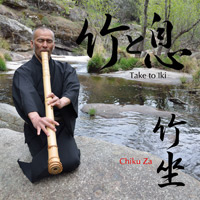
JIM FRANKLIN – Shakuhachi Zengarten-Meditationen/Zen Garden Meditations. A review by Gunnar Jinmei Linder
Dr Jim Franklin originally studied composition and musicology, and while so doing, he encountered the shakuhachi.
He began learning the honkyoku of the Chikuho-ryū with Dr Riley Lee. After that, he studied with Yokoyama Katsuya (1934–2010) and Furuya Teruo, and received his master license, shihan, from Yokoyama Katsuya in 1996.
As a performer, Jim has specialized in the honkyoku of Yokoyama-sensei (as transmitted by the Kokusai Kenshūkan), and both as a composer and a performer of modern music. This honkyoku CD contains tracks from both of the shakuhachi lineages that Jim studied: of the eight pieces on the CD, three are of the Chikuho-ryū and five of the Yokoyama style. This shows the width of Jim’s ability. It is not an easy task to learn different shakuhachi styles properly, but the recordings on this CD indicate how well versed Jim is in these two styles, and how comfortable he is in his playing.
The recordings were made in the Zen Garden of the Benediktushof, a former Benedictine monastery founded in the eighth century, which is now a retreat centre with the aim of creating a sense of integrated spirituality: Eastern thought, especially Zen Buddhism, in combination with the spirituality of Christianity. The setting is highly suitable for the meditative character of honkyoku, and the recordings are made ‘live,’ which means that birdsong can be heard throughout the album. The sound of the shakuhachi together with the sound of the natural surrounding give the recordings a very rich sense of closeness, a feeling that you are almost there when it happens. The sound has a rich ambience, without any of the surplus echo so often heard on shakuhachi CDs. This also gives a close-up sound image that is excellently detailed. It is so beautiful to actually hear the sound of the instrument and not a state-of-the-art recording technique, even if such technology has been used to record the music. It goes without saying that the performances are flawless in technique; as the shihan and experienced performer Jim is, he knows the tradition.
Already from the first tone, you can hear how well he knows the pieces. This is a requirement not always met in CDs of Japanese traditional music, maybe especially so with shakuhachi CDs. However, listening to “Zen Garden Meditations,” you do not need to worry about the accuracy or the authenticity of the performer’s execution. Yet, as it should be with honkyoku renderings, the interpretations of the recorded pieces all have Jim’s own distinct character, which gives the performances individuality without diverging away from the tradition. The concise explanations of the pieces (in German and English) also make it obvious for the reader that Jim’s understanding of the pieces is not only something that he has read; he is part of the shakuhachi tradition as a performer and as a transmitter. Jim’s performances are powerful, without loosing the subtlety of the pieces.
The first track, Kokū, is a very strong interpretation of one of the most well-known honkyoku pieces. This piece appears in many versions but they all require both stamina and technique from the performer. The intense sound of the shakuhachi blends with the more feeble but insistent birdsong in a most beautiful way, especially towards the end of the piece. This track stands in contrast to the last track on the CD, Hokyō Kokū, another Kokū piece transmitted within the Chikuho-ryū, which has much less ornamentation. The tonality in some lines of this piece strikes me as reminiscent of the court music, which gave me a new perspective of this piece. The second piece on the CD, Takiochi, is performed with the dynamics and precision required for the long, highly ornamented phrases depicting the water flowing towards the waterfall. Precision and dynamics are two keywords for all the recorded tracks.
This much said, I leave the rest of the pieces to the listener to judge and enjoy. I need, however, to make one critical comment to the explanation of the piece Kyorei. In the liner notes, it is stated that it is “one of the oldest honkyoku,” a statement that is debatable. To my knowledge, there are no historical remarks before 1795, when the legend about Fuke and Kyorei was published, that tell about the so-called three classics (Kokū, Kyorei and Mukaiji). The oldest text that mention any of the music played by the monks of the Fuke Sect, Shichiku shoshin-shū, was not written by a monk belonging to the sect, but by a professional musician. This text is from 1664, and it mentions other pieces than the above-mentioned three classics. We cannot really tell how old Kyorei or any of the other pieces actually are, and I believe it may give the wrong signals to state a historical chronology of the pieces when we do not have any accurate historical data to base it on. It is a central piece in the repertoire of maybe all the different lineages and schools, but maybe not “one of the oldest.”
This is a CD in all respects worth listening to. Honkyoku have fixed forms that are transmitted from teacher to student. This does not mean that they are not subject to change, but on the other hand, it does not mean that they can be performed at will or as one likes; the individuality of the performer will only show as an individual interpretation after having mastered all the aspects of the tradition to which the pieces belong. “Zen Garden Meditations” shows the excellence of technique in honkyoku playing by a master performer. The true-to-the-original interpretations are not mere copies, but have the individual interpretations, the mode of expression, and excellence of an artist. Jim has recorded some powerful interpretations, yet keeping a strong sensitivity for the aesthetic content of the pieces.
A highly recommended “Buy this!.”
Gunnar Jinmei Linder
(originally published in the ESS Newsletter, Issue 23, 2013)
Jim Franklin – Shakuhachi Zengarten-Meditationen/Zen Garden Meditations
Benediktushof Edition, 2011
www.bambooheart.com © & ℗, 2011 Total playing time: 64:02
Instruments used: shakuhachi in the length of 1.8, 2.0, 2.1, 2.4
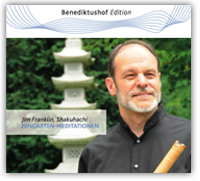
VÉRONIQUE PIRON – Nipponflutes. A review by Adrian Bain
This CD comprises pieces from different styles and periods from the shakuhachi repertoire and includes three duets adapted and arranged by Véronique Piron and Nishikawa Kohei, the eminent Japanese flautist.
1. Otachi Zake This minyo piece, played on a short shakuhachi in E, is calming and unrushed.
2. Yachiyo Jishi A duet, with the short shakuhachi in E making another appearance, this time blending nicely with nohkan and shinobue, with interesting melodies reflecting$ the Kabuki feeling of the piece. The mix of flutes do not compete, each claiming its own space, but not obstructing the other.
3. Tsuru no Sugomori Véronique’s handling of the standard shakuhachi in D is splendid. This version is from Sendai in the North-East of Japan and uniquely has an improvised middle section.
4. Finis-Terrae A new and pleasing composition by Véronique Piron with Breton Celtic roots.
5. Shika no Tone An interesting interpretation of one of the most striking pieces in the shakuhachi repertoire, played with the standard shakuhachi in D, nohkan and shinobue. The different natural pitches of the three flutes provides for a wide, complementary soundscape.
6. San’An Played on a long shakuhachi in B, San’An benefits from the excellent recording skills of Pierre Daniel, capturing important nuances in Véronique’s playing.
7. Trillium A composition for transverse flutes by the composer and performer Elizabeth Brown. This modern piece is fascinating and has some great, dextrous runs, engaging the attention throughout.
8. San’Ya Sugagaki A duet with standard shakuhachi and long shinobue, with the long shinobue leaving and returning throughout the piece, stitching the piece together in an interesting way.
9. Nagamochi Uta A minyo wedding celebratory piece, played on a long shakuhachi in B, emulates the human voice with repeated finger strikes.
The overall impressions received from Véronique Piron’s recording are unrushed and confident. I liked the quality of the recording. Pierre Daniel has captured a full, quite unadulterated sound, which is not too heavy on the reverb as some shakuhachi recordings can be. A lot of work has gone into this CD, by the players, the compositions and arrangements, the recording skills and the cover/booklet. Worthwhile work, producing an excellent CD.
Adrian Bain
(originally published in the ESS Newsletter, Issue 17, 2010)
Véronique Piron – Nipponsflutes
Homepage: www.veroniquepiron.com
CD page: CD Nipponflutes
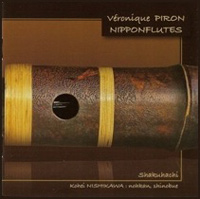
WATAZUMIDO – His Practical Philosophy (Musoshoku Muchoon). A review by Clive Bell
The marvellous maverick shakuhachi player Watazumido was born in Kyushu in 1911. As we near his centenary, Columbia Japan have reissued on CD a fascinating double LP, a mixture of lecture-performance and studio recording, that first appeared in 1974. Watazumido’s early recordings first arrived as ten inch vinyls on Polydor around 1962, but what we have here is an example of his mature style, recorded when he was 62 years old. Previously he had held two meetings in the US, one for Zen enthusiasts in New York, the other for musicians in Los Angeles – it would a treat to know which musicians exactly – and their success seems to have spurred him to try the same idea in Japan.
The album’s first seven tracks constitute a lecture about “Suijō”, ie Watazumido’s philosophical practice as expressed via flute playing. By the time they reached this point in the day, the audience had already heard Watazumido speak on “Avant-garde Philosophical Principle” and “Practice Of Watazumido-Dojo”. In the sleevenotes (in both Japanese and English, thanks to the English player Justin Senryu Williams), Watazumido repeatedly asks listeners not to confuse what he is doing with musical performance: “Many…might think of hocchiku (flute) as a performing instrument, being swayed by its shape and tones, and consequently might be unable to know the essence of Watazumido.” Thus the bar for listening is set pretty high: we are confronted with spiritual practice, a way (Dō) of Zen embodied in Watazumido himself. His very name makes no distinction between his person and his philosophy, being used to denote both. And the Japanese album title translates as “Non-adornment And Non-tuning”.
Watazumido demonstrates various blowing techniques, naming and briefly describing them, and illustrates his points by playing short versions of several pieces, including “Honshirabe”, “Tamuke” and “Tsuru No Sugomori.”
“Shingetsu” is wonderfully slow, while “Shishi” on a small flute is very high pitched. Finally he plays a full piece, an eight minute version of “Koku”: this is classic Watazumido, ferocious power and delicacy held in a fine balance. His dynamic range is extreme, and his phrasing can shock – notes leap out as if the player has been shaken like a flag in a violent breeze.
The following month Watazumido went into a studio and recorded five more pieces, the second half of this 65 minute album. Both “Sagarinami” and the beautiful old tune “Matsukaze” feature a pulsing breath. “Koro-sugagaki” is lighter, a skip and a jump. But “Kaze” (Wind) is remarkable: apparently a 90 cm bamboo split in the studio, so Watazumido seized the moment to tear out a wild improvisation on a small side-blown flute. It’s littered with trickery: flutters, Swanee whistle slides and unorthodox trilling, all done with warmth and a great tone. Who knows whether Watazumido was upset at losing one of his best flutes? This is surely his “Avant-garde Philosophical Principle” in action.
Clive Bell
(originally published in the ESS Newsletter, Issue 16, 2010)
Watazumido – His Practical Philosophy (Musoshoku Muchoon)
More info on this CD: Columbia Music Entertainment COCJ-35936 CD www.japanimprov.com
Buy & hear extracts: www.shakuhachi.com
Info on the original Watazumido LPs: http://www.tiliqua-records.com
Watazumido lineage notes by Justin Senryu Williams:
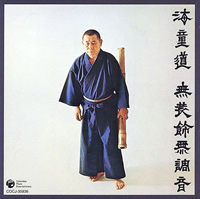
HOZAN YAMAMOTO & TADAO SAWAI – A New Sound From the Japanese Bach Scene. A review by Clive Bell
This is not so much a record review, more a short essay about a 1960s American LP of Bach pieces on Japanese instruments. The LP has never been reissued on CD, though it may be possible to track down old copies on the internet.
LP sleeves were so large, there was plenty of room on the front for text. A New Sound From The Japanese Bach Scene is the deliberately provocative title of this 1969 release. The words “JAPANESE BACH SCENE” are in the funky sword-slash typeface that screams ‘oriental’, ‘bamboo’ or ‘Chinese food’. The text continues: “12 familiar Bach pieces become a new experience as members of the popular “New Japanese Music Movement” do their own Baroque thing, with KOTO, SHAKUHACHI [more sword- slashing], Guitar, Bass, Drums”. Posed in formal costume, Hozan Yamamoto (shakuhachi) and Tadao Sawai (koto) gaze devoutly at a koto. Both were 32 when they recorded this. At least no one is wearing a powdered wig.
These arrangements of Bach’s greatest hits (“Air On The G String” and so forth) are by jazz pianist Norio Maeda, who doesn’t play on the album. Forty years later Maeda is 73 and still active, with his own page on MySpace. Acoustic guitar, double bass and drums supply a delicate, pastel shade of jazz rhythm in the background (well in the background – today it’s hard to believe anyone would record a bass so discreetly). Melodies are shared between shakuhachi and koto, and often a second koto is played by a young Kazue Sawai (Tadao’s wife). The fast Gavotte from the Third English Suite works well as a koto duet, while the second koto nicely doubles up the bass on the Largo from a harpsichord concerto.
Yamamoto’s shakuhachi rings out strong and clear, disguising the technical awkwardness of performing this chromatic music on a flute with no keys. In fact his intonation is so precise I suspect he used a seven-hole shakuhachi, which I believe was developed in the 1960s specifically to make Western music easier to play. Yamamoto is surely the most adventurous player of his generation: in 1964 he contributed to American clarinettist Tony Scott’s proto- ambient improvised set, Music For Zen Meditation. From this group he then took bassist Gary Peacock along to make his own modal jazz album, 1970’s Gin-Kai (Silver World), which remains (in my opinion) the most successful attempt at jazz on the shakuhachi (and a lot more satisfying than Yamamoto’s 2007 rendition of “Take Five”, which we can watch on YouTube).
So what’s the story underlying this record? What possessed these young Japanese players to “do their own Baroque thing”? Do these crazy Tokyo cats blow up a bamboo Baroque storm as they throw off the straitjackets of oriental formality? And do the geisha kids dig this “New Sound”? Well, maybe and maybe not. The sad fact is that while it’s efficiently played, today this seems a dull album. It’s a one-line gag: Bach on Japanese instruments, uh, okay. The playing is as straight-laced as jazz Bach could possibly be – not a single note is improvised, and no wit, dash or syncopation is permitted. All the more sad because Yamamoto & Co were clearly leaping aboard the Bach jazz bandwagon so successfully launched in the late 1950s by pianist Jacques Loussier, and Loussier’s playing just oozes humour and charm. The Frenchman’s non-deferential approach to J. Sebastian arrived at precisely the right moment, and he winked and twinkled all the way to the bank, selling six million albums in fifteen years. Yamamoto and Sawai, not being European, maybe felt they didn’t own this music and had better not mess with it, so the album remains stiff and po-faced.
On second thoughts, maybe I’m employing too much hindsight here. Let’s think back to the sixties context of the project. The record is on American RCA, who must have hoped that a combination of renewed interest in Bach’s music, an American postwar taste for Exotica, and an audience curious about non- Western instruments would ensure a positive response. The addition of a jazz rhythm section made sense in a world where Jacques Loussier and The Swingle Singers were omnipresent, but no one is pretending that this is jazz in any sense;; and so the record becomes a novelty item. It makes you wonder who put this project together: arranger Norio Maeda maybe? No producer is credited. A sleeve photo of the group onstage implies that live shows were tried out, but as a concept the jazzy Japanese Baroque thing doesn’t seem to have taken off – the album is a cul de sac.
What about the Japanese performers? Were Yamamoto and Sawai sending a message to the Japanese public? In the sixties Japan was already in the grip of great enthusiasm for Western classical music (not to mention jazz). Music students were busy laying the foundations for Japan’s eventual complete participation in the cosmopolitan classical scene, so that today a Japanese conductor, concert pianist or Bach choir will raise few eyebrows. And yet Japanese interest in their own traditional music was at an all-time low. Yamamoto and Sawai are a new generation crying out for attention – the modern audience is desperate for Debussy, lusting after Liszt, but associates koto music merely with posh restaurants. Why not listen to these instruments too, Hozan Yamamoto is pleading;; if they can play Bach this well, what else might they be capable of?
A parallel project in India was Call Of The Valley, a 1967 record by young tyros Hariprasad Chaurasia (bansuri flute) and Shivkumar Sharma (santoor). Chaurasia was only 29, and his flute was barely considered a classical instrument at all when his group blagged their way into an HMV studio and recorded a cycle of short ragas and composed melodies, moving from dawn to dusk through the simple story of a day in a Kashmiri valley. HMV got the shock of their lives when this youthful manifesto became the best selling Indian record of all time.
Finally, a composer’s perspective: a thought from Toru Takemitsu, who completed his breakthrough piece “November Steps” in 1967, two years earlier. Takemitsu devoted much thought to what a Japanese composer should be doing, and the essential differences between Japanese and Western musics. We can read his eloquent writings in “Confronting Silence” (Fallen Leaf Press, 1995). Here’s an example: “Speaking from my own intuition, rather than from a simple-minded resolution to blend Western and Japanese elements, I choose to confront those contradictions, even intensify them. And those contradictions are for me a valid visa for the world. That is my act of expression… Nothing that truly moves us will come from the superficial blending of East and West. Such music will just sit there.”
Clive Bell
(originally published in the ESS Newsletter, Issue 11, 2009)
Hozan Yamamoto & Tadao Sawai – A New Sound From the Japanese Bach Scene
RCA VICTROLA (1969)
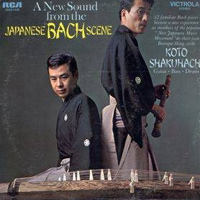
JORDI SAVALL & HESPERION XXI – Francisco Xavier 1506-1553: The Route To The Orient. A review by Clive Bell
Francisco Xavier was one of the young firebrands who founded the Jesuits’ Society Of Jesus in sixteenth century Paris. In 1540 he travelled to Mozambique, from where he was to spend the rest of his life roaming around Asia, including a two year spell evangelising in Japan. Xavier and his companions would stride along the roads of Kyushu singing psalms at the tops of their voices. This attracted large crowds of local people, and represents an early case of Western music being performed in Japan.
In 2007 the Catalan viola da gamba player and tireless leader of the Early Music group Hesperion XXI, Jordi Savall, produced a double CD to commemorate Xavier’s extraordinary travels. The albums come encased with a book in a deluxe package, and feature several excellent Japanese musicians: Yukio Tanaka on biwa, Hiroyuki Koinuma on shinobue and nohkan, and Ichiro Seki on shakuhachi. In fact the second CD is structured to dramatise Xavier’s final years, with Spanish choral hymns, Japanese pieces and a Chinese version of Ave Maria called upon to represent his progress through Japan and eventual death on an island off the Chinese coast.
As well as playing solo, the Japanese instruments improvise on the Marian hymn “O Gloriosa Domina”, alternating with verses sung by the choir. In 1605 a Nagasaki publisher brought out an edition of several Jesuit songs – Savall’s collage of musical juxtapositions is an homage to this early contact between Western and Japanese musicians, about which, sadly, hardly anything is known.
The Japanese musicians are understandably cautious in their improvising, sticking pretty closely to the hymn’s scale. Only Yukio Tanaka’s biwa pushes the boat out, slapping strings like gunshots, and scraping his plectrum menacingly down the string in that way that always makes me think of Hendrix. In fact Tanaka comes close to stealing the show altogether, with a stunning vocal-plus-biwa rendition of “Honnoji” (the story of the death of Nobunaga). This is great, dramatic playing, switching from delicacy to violence as only the biwa can.
On the shakuhachi, Ichiro Seki performs an eleven minute version of the meditative honkyoku piece “Reibo”. Seki, now in his fifties, is a pupil of Katsuya Yokoyama. He uses a deep-pitched flute with a soft, velvety tone. Throughout the album his sound is warm – more soft-edged than many players, but highly attractive.
Is this what Francisco Xavier would have encountered in sixteenth century Japan? We can only speculate. It’s fascinating to imagine the sheer bewilderment on both sides as the psalm-chanting Jesuits beheld court Gagaku players or village dances. In Xavier’s letters he is clearly impressed by the Japanese, whom he found “generally well-mannered…They eat with moderation, though they are less moderate when it comes to drink.” Jordi Savall’s album is at least a model of harmonious cooperation, with much beautiful playing and singing.
Clive Bell
(originally published in the ESS Newsletter, Issue 10, 2008)
Jordi Savall & Hesperion XXI – Francisco Xavier 1506-1553: The Route To The Orient.
ALIA VOX label 2xCDs. www.alia-vox.com
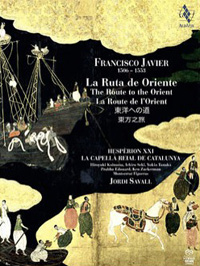
WATAZUMIDO – Sokuin Rancho/Ryohbo. A review by Clive Bell
Records by Zen priest Watazumi Doso Roshi (who died in 1992) have always been rare, so the re-release of two albums on a single CD by Universal Japan is to be welcomed. Especially as these are excellent recordings, displaying Watazumi’s whole range.
Watazumi was the maverick misfit of the shakuhachi: he founded his own Zen sect, and incorporated flute playing as just one element in his ‘way’, no more important than his martial arts practice, whirling a long stick. Stories abound of his unacceptable behaviour, megalomaniac remarks and unsavoury political connections, but few would deny his extraordinary skill on instruments which he made himself. These unlacquered bamboo flutes are called Hocchiku. Watazumi single-handedly took the shakuhachi tradition and shot it into orbit, to glow alongside visionary musicians like John Coltrane and Steve Lacy (who was an occasional pupil). “Man, that cat plays some bad shit,” might seem an inappropriate comment on many classical shakuhachi performances, but for Watazumi it’ll do fine.
This album comprises two LPs: Sokuin Rancho from 1970 and Ryohbo To Zen’ei from 1975 (when Watazumi was aged 65). From the latter there are just two tracks from the original seven – but one of those is 19 minutes long and perhaps the most remarkable Watazumi recording I’ve heard. The album’s overall length is a generous 67 minutes.
We open with “Furin”, an unhurried eight minute performance. These are Watazumi’s versions of traditional Japanese pieces – the method is to study the piece, “and then follow the rules of nature”, according to sleevenotes by the late radio presenter and ethnomusicologist Fumio Koizumi. “Murasaki Shoden” by contrast is a brief, breezy take on a folk melody. “Hokkoku Renbo” and “Soh Shingetsu” are similar: higher pitched, outdoorsy music, blustering and flapping like a flag on a mountainside. “Shin Kyorei” on the other hand is 16 minutes of stillness and velvety rumination.
If timbral range is one key to Japanese music, then Watazumi offers a masterclass in it. The colour of his sound is magnificent and varied, one minute fierce and low, the next a gusting squall of wind, then slipping into delicacy till the note almost vanishes. Koizumi’s sleeve essay makes the point that our idea of music needs to expand to accommodate what Watazumi was up to – he was a free spirit who happened to use shakuhachi to embody his ideas. One of his most extreme statements is the 19 minute “Ryohbo”. Here the microphone is closer, the sound intimate and the dynamic range astonishing. There are mid-note blasts here that are frightening, that can jolt you from your chair like a horror movie. Finally Watazumi reads one of his short poems, about getting up before dawn, culminating in a blood-curdling yell. The record should carry a health sticker warning off anyone who thinks Zen music might somehow be comforting.
Clive Bell
(originally published in the ESS Newsletter, Issue 9, 2008)
Watazumidoso – Sokuin Rancho/Ryohbo
UNIVERSAL MUSIC JAPAN, DCT-1882 CD
Sokuin Rancho CD information: www.japanimprov.com
Ryohbo CD information: www.discogs.com
Watazumidoso: www.komuso.com
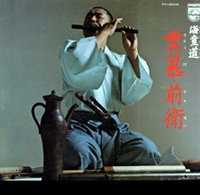
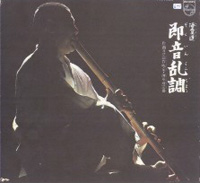
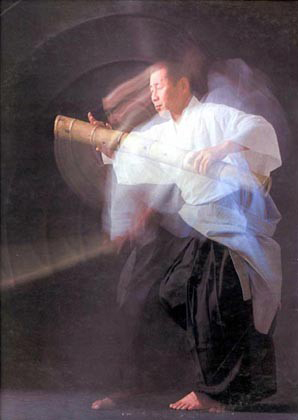
GORO YAMAGUCHI – A Bell Ringing In The Empty Sky. A review by Clive Bell
Goro Yamaguchi (1933-99) studied the shakuhachi with his father, Shiro Yamaguchi, during the second world war, and quickly rose to recognition as a leading player. In 1967 he taught for a year at Wesleyan University in Connecticut, and while in the US recorded two honkyoku pieces in New York: “Sokaku-Reibo” and “Koku-Reibo”. In 1969 these appeared on an LP in the Nonesuch Explorer Series, titled A Bell Ringing In The Empty Sky (the title taken from a colourful pseudo- translation of “Koku-Reibo”). Now Nonesuch have reissued the album on CD as part of their gradual re-release of the whole Explorer Series. The two tracks remain the same; the sleeve notes are unedited, though a bio of Yamaguchi has been added; but the wonderful monochrome psychedelia of the LP sleeve, in which a crane appears to fly through a geisha’s hair-do, has been replaced by a 1961 photo of a tiny fishing boat on the Inland Sea.
It’s probably hard to overstate the impact of Yamaguchi’s original LP in the West. One has to think back to a benighted generation when not only had no one ever heard a shakuhachi, but the idea that Japanese music might have depth to it, that it might have a rigour that could stand alongside European classical performance, was thrillingly new and taboo-busting. Inviting Yamaguchi to teach at Wesleyan was a pioneering move, and A Bell Ringing was the first widely available recording of a completely new music. It took its place alongside Ravi Shankar, Stockhausen and Hawkwind on the shelves of discerning record buyers, and aspiring music-makers and composers marvelled at its qualities. By 1977 a portion of the recording was included on a compilation of “Earth Music” aboard the Voyager II spacecraft. Having conquered hip record stores, Yamaguchi was off to new galaxies.
How does Yamaguchi’s record stand up now, forty years on? The first thing you notice is the overall length: at under thirty minutes, this is what we would now term an EP. Nonesuch clearly had no extra material in the vaults to flesh out the CD version. Having said that, Yamaguchi’s versions of these classic pieces are unusually long: “Sokaku” at thirteen minutes and “Koku” at fifteen represent extended explorations. The sleeve notes, despite being written by respected ethnomusicologist and broadcaster Fumio Koizumi, are misleading and, when it comes to scales, hilariously inaccurate. However there is an honourable tradition of album notes getting these things wrong, and if a sleevenote writer starts talking about scales it’’s almost guaranteed that what follows will be nonsense.
Yamaguchi performs both pieces on a 1.8 shakuhachi. His playing always has poise; it is elegant and cool to the point of chilliness. “Sokaku” (Depicting The Cranes In Their Nest) is largely static, in that Yamaguchi stays in one small pitch area for a long time, but highly ornamented –– a picture of young cranes bickering at home and not taking flight. After ten minutes the piece calms down and moves to the lower octave. “Koku” spends more time in this lower octave and is generally slower and more meditative. It’’s also a warmer, more human performance, and Yamaguchi’’s playing features some lovely, subtle dynamics.
Even at the date of its first release, a Western listener might have judged that Yamaguchi’s shakuhachi style was not the only game in town. In 1967 the New York label Lyrichord issued Japanese Masterpieces For The Shakuhachi, an LP of five pieces from anonymous monks at Kyoto temples (this is also available on CD). At the time this may have seemed an inferior record: the performances are rough and unsophisticated, the sleevenotes dodgy as ever (Fuke monks are termed “tootling preachers”), and the vinyl pressing of poor quality. Now things look a little different. Yamaguchi represents a shiny new breed of player, both refining and formalising the old techniques so that the instrument is ready to don bow tie and tails, as it were, and enter the Western concert hall. Lyrichord’s unnamed tootlers, on the other hand, are playing on their home ground. The two monks playing “Koku” are inside the Meianji temple, and their temple bell is incorporated into the track. This music has some function in their daily life, and plenty of meaning as an activity: not a show for an audience but a spiritual exercise. Whereas Yamaguchi’s music floats free in an empty sky, divorced from context. What is it for? It’s for consumption, live or on record, by the new audience, according to Western models of art music.
The effect of Yamaguchi’s record on his Western listeners is one thing, but what about its effect on Japan? By 1969 Japan had invested pretty much a century in a massive adoption of Western culture and technology. Beginning with the import of brass bands, new musical ideas had taken root: the importance of playing in tune; formalised and fixed versions of pieces; large groupings of instruments, or orchestras; and concert halls where the audience politely listens in silence. Any of these notions would have astonished our old friend, the tootling Komuso player beneath his basket hat. But by the 1960s Japanese performers of European classical music were receiving international acclaim, Toru Takemitsu was on the point of acceptance as a world class composer, and the figure of the globetrotting concert hall soloist was completely familiar to Japanese audiences. Yamaguchi’s performance, highly polished and beautifully recorded, slots into place as an early step in Japan’’s resumption of confidence in its own traditional culture. The Tokyo Olympics were in 1964; around 1976 my own teacher, Kohachiro Miyata, went onstage solo at the Carnegie Hall.
There’s no question that Yamaguchi was one among a generation of marvellous shakuhachi performers, and it’s fascinating to see how they differ from one another. Another version of “Koku”, played by Katsuya Yokoyama, is on the excellent The Art Of The Shakuhachi on Ocora. One year younger than Yamaguchi, Yokoyama was 63 when he made this record. He continued studying with the Zen master Watazumi until the latter’’s death; this must have kept Yokoyama in touch with the down to earth Fuke monk tradition, and its concerns with matters other than music. Yokoyama retains an unpredictable exuberance in his playing. His crane piece (“Tsuru No Sugomori”) attacks the famous passages of flutter tonguing and tremolos with an animated, improvisational attitude. Thirty years earlier, Yamaguchi sounds correct and formal, a musician on his best behaviour, as if slightly in awe of the future status of his recording.
Clive Bell
(originally published in the ESS Newsletter, Issue 6, 2007)
Goro Yamaguchi – A Bell Ringing In The Empty Sky
NONESUCH EXPLORER CD
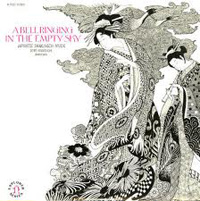
SABU ORIMO – Susabu and Ichion. A review by Clive Bell
Two solo albums on the tiny Japanese label Subjective Spirit Sound contain the most remarkable shakuhachi playing I’ve heard in years. Sabu Orimo is a player still in his twenties, with a fine lineage: both his parents were musicians in Punk groups. He studied shakuhachi with Atsuya Okuda and plays exclusively ji- nashi “hocchiku” flutes, large, natural bamboo with no lacquer or special treatment to affect the sound. His concert posters announce “Noise Shakuhachi Solo Live”, while his label describes him as playing “Japanese old stone age style”.
Susabu consists of nine pieces all recorded on 28th March 2006. The opener is a passionate treatment of the honkyoku “San-an”, full of busy flurries, gasps and violent stamping noises. It recalls the master Watazumido, but if anything is even more uninhibited and earthy. But Orimo’s control is firm –– he often swivels into silence, and the piece closes with great calm after the storm. A version of “Koku” is meditative and beautifully paced. Here you can clearly discern Okuda’s influence, and at seventeen minutes it’’s the same length as Okuda’s own recording.
Orimo also plays the honkyoku “Sanya” and “Honte No Shirabe”, but almost half of this album appears to be improvised. Susabu’s title track is in two parts, between which Orimo probably needed to lie down in a darkened room. “Susabu Part 1” is a full-blooded outburst, culminating in an almighty thump. In “Part 2” Orimo snorts down the flute like a trumpet, and roars as if possessed. The recording equipment reels under the onslaught – this is a demented howling you expect more on a lo-fi Punk record. It’s a shock, but somehow integrated into the story that Orimo is telling. His sound has such integrity that he can carry the listener with him; as with Albert Ayler’s saxophone, you feel that if he needs to extend his emotional range this wide, then so be it.
Susabu concludes with an extremely low-pitched and restrained track titled “Tsukiyo”. In spite of all this, it’s Ichion, Orimo’s second album, recorded two weeks later, that is one of my favourite records of 2006. Four of the five tracks are played on a long and low flute. Here what’s remarkable is how little Orimo does and how good his timing is. Three minutes can be devoted to exploration of one quiet note. The outside world creeps in around the edges: on “Yure” we can hear it’s pouring with rain. Five minutes in, Orimo makes his move. Gusts of wind whip through the bamboo, then he returns to stillness. These are extraordinary performances that seem to dig deep into Japanese tradition.
Clive Bell
(This review was originally written for The Wire magazine: www.thewire.co.uk)
Sabu Orimo – Susabu and Ichion
Susabo CD: Subjective Spirit Sound
Ichion CD: Subjective Spirit Sound
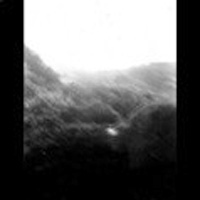
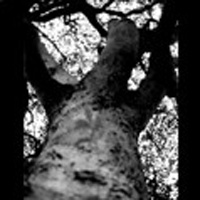
YOSHIO KURAHASHI – Honkyoku, Zen music for shakuhachi. A review by Kiku Day
Yoshio Kurahashi spends almost as much time outside Japan teaching and performing shakuhachi as in his native city Kyoto, the ancient capital of Japan. Kurahashi is a master player of the Japanese bamboo flute in his own right. He belongs to a new generation of players who play this instrument powerfully and virtuosic. In the hands of Kurahashi the shakuhachi, once used by monks of Fuke sect of Zen Buddhism as a tool for meditation, is no longer an esoteric instrument but an instrument for the concert stage.
Kurahashi is a skilful interpreter of 20th century music for shakuhachi but on this CD he plays honkyoku, the repertoire of the Fuke monks. ‘Tsuru no Sugomori’, a programmatic piece about the life cycle of a couple of cranes is played masterfully and with great sensitivity.
All six pieces have been recorded at different locations including different temples. ‘Hōrai’ is recorded in the gardens of Kokutaiji temple, and others are live recording in a concert hall or recorded near a waterfall. The sound of nature is heard, the river running and birds chirping. This is a charming idea, but the beautiful sound of the shakuhachi gets lost in the recording – a great loss for the otherwise well performed CD. Honkyoku, Zen music for shakuhachi is a good CD, but had the recording been better – it would have been great.
Kiku Day
(Originally written for Froots)
Yoshio Kurahashi – Honkyoku, Zen music for shakuhachi
CD (67 mins), Inedit, W 260134
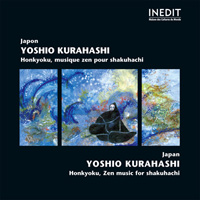

CONTEMPORARY MUSIC FOR SHAKUHACHI
FRANK DENYER – Music For Shakuhachi. A review by Clive Bell
This record is all about a friendship between Frank Denyer, for many years a teacher at Dartington College Of Arts in Devon, and shakuhachi master Yoshikazu Iwamoto, who also taught at Dartington in the 1980s. The two first met on an ethnomusicology course at Wesleyan University in Connecticut, where they played Japanese music together. Already interested in flute-making and microtonal tunings, Denyer wrote a series of demanding compositions for Iwamoto over the next twenty years.
“On, On – It Must Be So” (1977), as the title suggests, is driven and dynamic. The shakuhachi’s agile gymnastics are egged on by castanets and bass drum. The music sounds tough to play, and there’s a lurking sense of the performer leaping through hoops. By contrast, “Quite White” is a solo built from serene, swooping glissandos. “Wheat” is a suite of six short pieces: Iwamoto’s shifting tone colours and ambiguous pitches are nicely complemented by delicate tapping on stones, bamboo slit drums and an artillery shell. These three compositions were previously heard on a 1984 LP titled Wheat, but the reason the present album has been keenly awaited is the 45 minute monster “Unnamed”, which Iwamoto recorded in 1999 and has never been released. “Unnamed” has legendary status among shakuhachi players, and full credit to Simon Reynell’s new label, Another Timbre, for finally putting it out. Iwamoto retired from playing after a serious illness several years ago, so we are lucky he recorded this when he did.
“Unnamed” may be a pianissimo epic, but it’s strongly structured and sustains interest well. Broadly we are in the territory of Morton Feldman’s Second String Quartet, but Denyer patiently explores an extraordinary range of timbral colours, from quavering in-breaths to gasps of sobbing notes. Iwamoto plays with quite magical delicacy. Many of these notes are so spectral that a hypnotic aura of sonic mystery descends like a veil, only to shoved aside by vocal cries or monk-like growls. Always keen to build from scratch on uncharted land, Denyer has constructed an unusual soundworld here – though some improvisers have also ventured into this territory recently via
a different door. Iwamoto dedicated himself wholeheartedly to realising Denyer’s challenges, and this record is a crucial part of his testament.
Clive Bell
(This review was originally written for The Wire magazine: www.thewire.co.uk)
Frank Denyer – Music For Shakuhachi
ANOTHER TIMBRE CD www.anothertimbre.com
Frank Denyer’s site is at www.frankdenyer.eu
Here you can read the sleeve notes for Wheat – Yoshikazu Iwamoto’s own thoughts about playing this music.
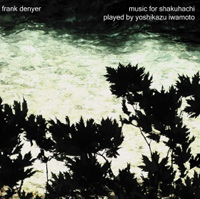
FRANK DENYER – Music For Shakuhachi. A review by Kiku Day
This CD is a landmark of contemporary works for the Japanese end-blown notched oblique bamboo flute, the shakuhachi, written by the British composer Frank Denyer and played by IWAMOTO Yoshikazu. The shakuhachi is one of the most successful non-Western instruments to enter the world of new classical or avant-garde music in recent years. The CD comprises four compositions, written between 1977 and 1997, and through them the listener can follow how Denyer ventures ever deeper into the possibilities of the shakuhachi and utilises to the maximum Iwamoto’s impressive playing skills. More than most composers, Denyer creates his own unique sound world. His music here sounds completely unlike traditional shakuhachi music, the so-called honkyoku played by the komusô monks of the Fuke sect of Zen Buddhism, nor does it fit any particular genre in contemporary music. Rather, it constitutes a distinctive musical world, perfectly rendered by Iwamoto’s otherworldly playing.
Denyer and Iwamoto met in the 1970s at Wesleyan University (USA), where Iwamoto was artist in residence in the World Music programme and Denyer a doctoral student in ethnomusicology. Denyer is also a koto (Japanese zither) player and has a thriving career as a pianist, alongside his professorship in composition at Dartington College of Arts.
Denyer’s shakuhachi compositions are very difficult to play, requiring almost superhuman control of this already very difficult instrument. The player is forced to create new techniques in order to play the material as written. Denyer’s deep engagement with Indian music seems to have influenced his rhythmic aesthetics, providing his compositions with a complexity in sharp contrast to traditional shakuhachi music, which calls for a free interpretation of time and phrasing. And yet Denyer’s compositions for shakuhachi suit the instrument very well; the difficult writing is not due to a lack of knowledge of the instrument—Denyer just writes difficult music. In fact, the careful listener soon discovers the care the composer has taken to remain true to the nature of the instrument while at the same time challenging it. Denyer’s dynamic markings and his writing require a player of the calibre of Iwamoto, who fearlessly accepted the challenge and dedicated a large part of his performing life to deciphering Denyer’s music. This CD is thus the fruit of an intense and unique musical friendship and collaboration between composer and player.
The first four minutes of ‘On, on—it must be so’ (1977-8) are in a tempo and density that takes the breath away from even a listener who plays the shakuhachi. The melody line, accompanied by castanets and bass drum, moves restlessly on to the next finger-twisting challenge. After a stroke on a metallic percussion instrument, the percussion becomes silent and the piece slows down and enters a realm of beautiful serenity before ending as energetically as it began. Iwamoto’s dexterous rendition of the portamento alone makes this piece impressive.
‘Quite White’ (1978) is characterised by restrained dynamics at the top of the shakuhachi’s range. What most strikes the listener is Iwamoto’s skill in playing pianissimo in registers where the instrument, in the hands of most players, can only produce notes in forte. Together Denyer and Iwamoto are exploring new possibilities of timbre and expression on the shakuhachi. The tempo of ‘Quite White’ is slow, although Denyer has expressed his reluctance to write slow pieces for the shakuhachi as most of its traditional music is slow. However, in ‘Quite White’ Denyer again shows his mastery in creating his own music. The music is as elusively transparent as water and, at the same time, as solid as a rock.
‘Wheat’ (1977-81) consists of six pieces, all of very different character. ‘Instruments’ such as stones, bamboo slit drum, sandpaper blocks and various steel plates employed as gongs all accompany the shakuhachi. Here, Denyer explores new and surprising possibilities of tempo and intonation for this instrument, and Iwamoto moves with dexterity through these novel melodic lines.
‘Unnamed’ (1997) is the only piece on this CD which has not previously been released on LP. This 45-minute piece is a celebration of restrained pianissimo playing and microtones. Denyer has notated the score in several colours to differentiate the conflicting scales, so that the player knows which scale is being played. Although Iwamoto has written on his systematic approach to playing microtones on the shakuhachi (1994), he does not seem to have anchored his system sufficiently in his students before abruptly retiring from shakuhachi playing—a great loss to future shakuhachi players of new music.
Although the CD was released ten years after the last piece ‘Unnamed’ was written, the musical fruits of the collaboration between Denyer and Iwamoto are as cutting-edge today as they were at the time the pieces were written and performed. No performer today can really match Iwamoto in his dedication to playing music so extremely challenging to the player’s rhythmic precision, dynamics and technical skills.
This CD is a testimony to a collaboration between composer and performer that took shakuhachi playing to a new level. It is also an important milestone in the history of the instrument and an affirmation of the role it can play in genres outside its own tradition. The popularity of the shakuhachi is growing rapidly outside Japan. Players throughout the world, enchanted by its unique and haunting timbre, are introducing it in new genres and inventing new playing techniques. This CD is a monument to shakuhachi music without roots in any particular tradition. It demonstrates just how much an instrument of the world the shakuhachi has become.
References:
Iwamoto, Yoshikazu. 1994. The potential of the shakuhachi in contemporary music. Contemporary Music Review 8(2): 28-32.
Kiku Day
(Originally written for British Forum for Ethnomusicology)
Frank Denyer – Music For Shakuhachi
ANOTHER TIMBRE CD, 2007 www.anothertimbre.com
Single CD with 8-page booklet
Text and liner notes by Bob Gilmore

MARTY REGAN – Forest Whispers… A review by Kiku Day
Marty Regan is a composer who fluidly – like water – moves between Japanese and Western classical music and blends the two in the most natural way. The music is a testimony to the fact that Regan is bi-musical and writes for instruments such as the Japanese bamboo flute shakuhachi, long-necked lute shamisen, zither koto and percussion ko-tsuzuumi as well as piano and violoncello. He creates a unique sound world of his own that simultaneously feels classical and modern to the listener.
Regan carefully juxtaposes the instruments whether they are from the same or different traditions and find common grounds in their musical expression, on which he build the piece. He gracefully takes the listener on a journey moving between Western and Japanese traditions so that even the attentive listener looses track when these borders were crossed and transcended.
Track 1, Song-Poem of the Eastern Cloud is a shakuhachi and koto duet. Both Japanese instruments move gracefully in and out of phrases where the listener is tempted to listen for Eastern or Western intervals and sounds… however it is elusive and one is left with the feeling of oneness.
Track 2-4, Evanescent Yearning for shamisen and koto is a refreshing piece where Regan uses traditional techniques in such a way that they become new. The piece has serenity and pace to it that makes it feel like the sounds are sparkles of light in a river passing by gently.
Track 5, In remembrance, shakuhachi, Violoncello and piano. In this trio, the unique sonority of each instrument contrast with and supplement each other simultaneously. Regan uses in particularly the shakuhachi as if it was a chameleon. He makes the sound of the shakuhachi cross cultural borders and musical boundaries.
Track 6, Fastpass, shamisen and ko-tsuzumi. Here Regan shows his jazzy and humoristic side for which the shamisen is a perfect match. This piece is full of life and innovation. The buzz effect of the shamisen is well integrated into the piece and so is the voice of he ko-tsutsumi player.
Track 7, Forest Whispers… shakuhashi, violoncello is a powerful musical composition and interpreted skilfully by the musicians. The phases of both instruments are intensive with a rich timbre full of overtones.
Marty Regan is surely a composer, from whom we will hear more. I am already looking forward for Selected works for Japanese instruments, Vol II. The only regret I have is that, as the pieces are all beautifully performed – and I wish I knew who are playing as I do not recognise all the people on the list of acknowledgements.
Kiku Day
(Originally written for Navona Records)
Marty Regan – Forest Whispers…
www.navonarecords.com
www.martyregan.com
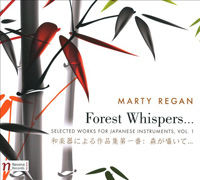

OUTSIDE OF TRADITION, SHAKUHACHI IN EXPERIMENTAL/IMPROVISATIONAL CONTEXTS
CORNELIUS SHINZEN BOOTS – Mountain Hermit’s Secret Wisdom. A review by Philip Horan
This newly released CD by Cornelius Boots was recorded deep in a cave-tunnel formed by gold miners in Nevada County, California. The ambient background water sounds offer the perfect compliment to the resonance of the long Taimu shakuhachi. These jinashi shakuhachi of Ken LaCosse are wide-bored, each with a distinctive timbre and tuning. The richness and earthly tone of these jinashi monsters is captured perfectly without any distracting echo.
There is a blend of traditional honkyoku mixed with ‘mukyoku’, pieces composed by Cornelius Boots specifically for Taimu shakuhachi. Mukyoku are similar to honkyoku in their long tones but contain echoes of blues and Native American flute music. The CD or download come complete with scores of all pieces. The natural multiphonics present in these Taimu shakuhachi, mixed with splashes of muraiki, creates a dirty sound which is enjoyed in tracks such as Ekoh and ‘In Which the Sound Contemplates Your Existence.’ Other tracks such as Banshiki and Shingetsu are meditative and contain long breath tones and ample space between tones to enjoy the water sounds. This album is a must for jinashi warriors and Taimu aficionados.
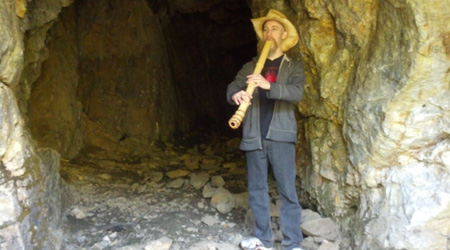
“Creating sound through the bamboo tube of the flutes inside of the earth tube of the cave feels like a remarkable, resonant collaboration of earth, air, plant, consciousness, and the Zen Buddhist shakuhachi tradition itself.” Boots
Philip Horan
Cornelius Shinzen Boots – Mountain Hermit’s Secret Wisdom
Cornelius Boots: www.corneliusboots.com
Album information and available at CD Baby
Taimu shakuhachi and mukyoku scores: Mujitsu.com

DAVID ROSS & CLIVE BELL - Recovery Suite. A review by Jim Franklin
Recovery Suite is an unusual recording in a number of ways. Firstly, it combines two disparate sound worlds – the “natural” sound of the shakuhachi, and the “artificial” world of electronically-generated and -manipulated sound – and deliberately questions their apparent antithesis. It also questions the nature of the recorded medium – in the days of mp3 files or CD recordings, the album has been released as a vinyl pressing, an art work not stored in digital form, and thus not inherently open to immediate and unlimited duplication. It is an object, tangible and thus more than a transient presence. Apart from its musical qualities, this lends the recording an intrinsic value, which is enhanced by the limitation to a production run of 250 copies (according to the press release).
So what is this unusual music? The press release suggests that David Ross initiated the project while bedridden and recovering from a back injury; during this time, the only instrument he could play was electronics. Clive Bell was later drawn into the project as shakuhachi-player and co-composer. Given the circumstances, the subject matter of the pieces is not surprising; they all relate to aspects of illness in various forms – physical as well as mental – reflected in the titles (such as “Trauma Unit”, “Locusts of Analgesia”, or “Recovery”).
Broadly speaking, the sound world reflects these themes; the electronic sounds, often in the form of loops, are reminiscent of, but by no means limited to, the sonic texture of medical electronics in an intensive-care unit – bleeps, hums, drones. The shakuhachi, which does not appear on every track, is nevertheless also drawn into this world. Its sounds are often ambivalent, ranging from noise, through tonally uncertain sustained notes with dynamic shifts of pitch and vibrato, through to trills and techniques (such as korokoro) which are clearly related to the shakuhachi canon.
While the shakuhachi has a clear canon on which its contribution is based, there is no such standard repertoire for the electronic elements. According to the press release, David Ross plays a customized analogue oscillator, known as a “Drosscillator”. Judging by the nature of the sounds produced, this is a rather complex instrument, allowing for a broad range of manipulation of pitch, timbre and dynamics, from subtle distortion and filtering of sound, through to generation of non-harmonic overtone structures (presumably though ring modulation and frequency modulation), as well as percussive drum, cymbal and gong sounds. In fact, the sound world of the electronics is reminiscent of that produced by Buchla series synthesizers; although no technical details are given, it would not surprise me if the Drosscillator were conceptually related to these instruments. (This is by no means intended as a denigration, but rather as a compliment to the richness and warmth of the sound world produced, and as an aid for those with a background in music synthesis to imagine the sonic atmosphere of the record.) It is also apparent that either the Drosscillator contains many oscillators and signal processing units, or that a process of multitracking has been employed in making the record; the press release and record cover provide no clues as to whether any multitracking was carried out in the digital domain, or using an analogue tape recorder, which would be conceptually consistent with the release on an analogue medium (LP record).
The combined sound world of shakuhachi and electronics tends, in this recording, to have something of a dream-like character. For some of the tracks, the term “nightmare” might be more appropriate; Ross and Bell have included the uncomfortable and disturbing elements of illness in their music. Drawing influences from free improvisation and loop composition (often with electronic percussion loops and drones which cast a nod to the electronica scene without being limited to the musical syntax of that genre), the pieces tend to come and go as open forms, and dream-like discontinuities and shifts of material and texture are common. The result is not aesthetically “rounded” or “satisfying” in the sense that, for instance, Western classical music aims at aesthetic polish; rather, it is disturbing, without being “threatening” – and above all, it is fascinating, drawing the listener in.
Despite the openness of the forms of many of the tracks, there is nevertheless a clear level of structural thinking in the pieces’ composition. This is demonstrated particularly in the exploration of the relationship between the sound worlds of the shakuhachi and the electronics, which is (in my perception) an important aspect of the project. The apposite questions are: do these sound worlds meet and merge? And if so, how? The answer to the first question, I believe, is “yes”, and I consider this to be one of the successes of the recording. Of the eleven tracks on the LP (the last of them without title, a “hidden” bonus track, as it were), three are without shakuhachi, at least in any obvious sense; I won’t exclude the possibility that some of the sounds in these tracks are derived from the shakuhachi by processing which obscures their origin. The others evince various forms of interrelationship: from apparent opposition (at the start of Side A, track 6, “Sleep Healing”), through to a high degree of unification (in Side B, track 4, “Arrhythmia 2”), in which the more or less acoustic sound of the shakuhachi appears to be paralleled by a processed version of the same line (with vibrato, filtering, modification of harmonic content) in textural counterpoint with electronic sounds (gong-like loops, and ethereal, triadic, sustained tones). The tracks which employ shakuhachi with the electronics all locate themselves somewhere on this spectrum; I personally find “Sleep Healing” particularly interesting, as it runs the entire gamut from contrast between shakuhachi and electronics, through to their integration, and the shakuhachi emerges at the end of the piece as the dominant force.
The result of the levels of musical thought and exploration of these diverse sound worlds and their interrelationship is a highly unusual and, I believe, successful recording. The fact that this is a niche work is clearly recognized by the musicians, as evidenced by the production of only 250 copies. Nevertheless, it is an interesting and significant niche work, and the recording deserves to be heard by many more than the 250 people who will eventually own the LP.
Jim Franklin
Dr. Jim Franklin is a shakuhachi master in the Kokusai Shakuhachi Kenshukan; he received his shihan-menjō from YOKOYAMA Katsuya in 1996. He is also a trained composer, and he frequently works with the combination of shakuhachi with live electronics.
David Ross & Clive Bell – Recovery Suite.
LP @ 33 RPM, 250 copies, hand numbered, with 2 inserted opioid postcards.
Arrhythmia 1
Trauma Unit
Immersion
Symptom Sequence
Locusts of Analgesia
Sleep Healing [side B = 5 tracks, 21:20 min]
Post – Trauma Unit
Valium of the Butterflies
The Recovery
Arrhythmia 2
(“secret track”)
Released on ini.itu Records: www.iniitu.net

SABU ORIMO – Kamakura Juniso. A review by Clive Bell
In 2006 Sabu Orimo caused a stir with a couple of albums on the tiny Japanese label, Subjective Spirit Sound. Although he had briefly studied with Atsuya Okuda, he appeared an unschooled but passionate shakuhachi improviser, one moment snorting or roaring down the instrument in a blast of acoustic ‘Stone age noise’, the next hovering in uncanny stillness. Enjoy it or not, here was a musician tracing his own path. Now Kamakura Juniso, recorded in 2012, is a change of direction. In his own words, “Until now I created my sound by subjectively colliding with my inner screams. This time, my sounds express my ideal paradise, like drawing pictures of Juniso.” The album is partly a response to Orimo’s relocation to Juniso, a leafy corner of east Kamakura. However, in common with many Japanese artists, he seems in shock from the Great East Japan Earthquake: “Because of this Earthquake, I realised that I have a chance to question my own way of life.” He titles one track “Requiem – Peace From Tohoku.”
I found Orimo’s early recordings original and exciting, but Kamakura Juniso is too much of a sugary confection. Several of these nine tracks meander through Celtic-style pentatonic scales, with twirls and trills striving for prettiness. The trouble is Orimo himself doesn’t sound wholly convinced, particularly by the seasick swaying of “Birds”, as it drifts out of tune. In this melodic style, intonation needs to be precise, and Orimo’s strengths lie elsewhere. His desire to work from “simple and naïve sounds” is compromised by the generous digital reverb, which was almost certainly not the natural resonance of the small room where he was recorded (a couple of times the birds outside join in, and Orimo ups his game, playing with more intensity). The exception is the deep “Grand Bleu”, possibly played on a massive bamboo with no fingerholes, where he does great work with just the harmonic series.
Swapping raw sonic exploration for sweet-toothed platitudes feels like a cul-de-sac for Orimo. Kamakura Juniso is the sound of a fine player passing through a transitional phase of confusion.
Clive Bell
Sabu Orimo – Kamakura Juniso.
Innerside Records CD
CD info at discogs

VIZ MICHAEL KREMIETZ – Suizen. A review by Philip Horan
This is an album by shakuhachi player, Viz Michael Kremietz. My overall impression is one of stillness, no doubt aided by the effective use of water sounds in the opening track. These natural sounds are superbly recorded and integrated into the rich jinashi tones. The album contains some original pieces with background sounds and four honkyoku. The latter are not an exact playing from the score but Viz’s interpretation of the essence of each honkyoku. This makes for a rich listening experience as one tries to recognise familiar phrases. Viz uses a mix of different size shakuhachi, each with a distinctive and rich timbre. He remains true to the suizen tradition of following each breath to the end and enjoying the space between the tones.
The design and presentation of the CD are superb and based on Viz’s recent collaboration with Alexander Lauterwasser, a famous German scientist who makes water-sound figures. The water- sound video of Tamuke, which is featured on the CD can be found on his website: http://youtu.be/iV71L04PN-s
Viz is involved in combining the shakuhachi with other artists in innovative ways. His current and past projects can be viewed on his website: www.paraviz.com
Philip Horan
(originally published in the ESS Newsletter, Issue 22, 2012)
Viz Michael Kremietz – Suizen
www.paraviz.com
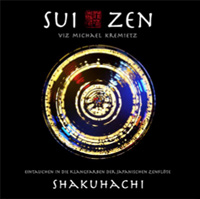
THORSTEN KNAUB – Listening Station: music for abandoned structures and shakuhachi. A review by Joe Browning
If this issue of the ESS newsletter aims to explore the ‘The World of the Shakuhachi,’ then Thorsten Knaub’s album marks an unusual position in that landscape. The main dome of the former US Listening Station at Teufelsberg in Berlin is not a location readily associated with the shakuhachi. But Listening Station: music for abandoned structures and shakuhachi, plays its part in expanding the sites and sounds we connect with this instrument.

The station; part building, part technological device – was used to listen in on radio communications during the Cold War, and stands on a hill constructed from the rubble of WWII Berlin. As well as having a remarkable history, the station also possesses a remarkable acoustic: single tones sing on indefinitely, breathy muraiki take on a harsh edge, sounds overlap and intertwine. The reverberation of the structure is not only powerful and long-lasting, it also heightens the contrast between a sound and its overtones, and sets them spinning around inside the dome.
So Listening Station is very audibly a site-specific recording. The first track, Improvisation I has a distinctly exploratory character. We hear Knaub testing the acoustic with single notes, allowing lots of space between sounds and gradually introducing more complex gestures. At one point, he sets up a chord-like texture, playing plain notes in regular succession so that harmonies pile up in ways that are seldom possible on a solo shakuhachi album. Occasionally, harsh percussive noises appear, which Knaub told me are the sounds of other people in the dome kicking tin cans. Improvisation II has a brighter quality, centered around the pentatonic of the shakuhachi’s open holes. Where the opening was relatively dark, with large melodic leaps and dissonances, here the mood is more extrovert, perhaps reflecting Knaub’s increasing familiarity with the space (the album corresponds largely to the order of his live performance).
At the centre-point of the album is its only honkyoku, Tamuke. While reminiscent of Riley Lee’s honkyoku recordings in the National Acoustics Laboratory in Sydney or the Jenolan caves, the station’s acoustic is harsher and more unpredictable. Knaub plays Tamuke with assurance and the piece’s familiar melodies are interestingly reshaped but still recognisable amidst the reverberation. It is tempting to hear this Tamuke as a requiem for the abandoned Listening Station or the Cold War conflict it represents. However, Knaub told me that, while remaining aware of the site’s layers of history, the recording was more a spontaneous engagement with the space, rather than an attempt to tell a particular story about it. For this reason, he places Tamuke as a transition between improvisations, rather than at the culmination of the album. This was a fruitful choice as it provides the listener with a contrasting section in what would otherwise be unbroken improvisation. Reaching Improvisation III, we are ready for more as the shakuhachi is joined again by insistent percussive sounds, and then by the sound of a recorder, played by another musician visiting the Listening Station. The music takes on a more tense character as all these different sound-sources interact, with dramatic moments as explosive noises seem to trigger outbursts on the shakuhachi. A return to the opening mood in Improvisation IV brings a symmetry to the overall listening experience.
The danger in a recording like this is that the space could dominate, amplifying the performer’s sense of their own power and reshaping the music so forcefully as to remove subtlety. Here, flurries of notes sometimes do get tangled together, and the improvisations occasionally struggle against the inevitable long fade of the dome. But to say that Knaub is not in complete control, that there are some gestures which do not work, is not to detract so much from the album. In fact, Knaub seems to embrace the exploratory nature of the situation, treating the arrival of another musician, explosive interruptions or the structure’s unexpected interventions as opportunities for response. As he told me, playing in the space took on a ‘narrative’ quality, as he adapted to the acoustic. In all, Knaub proves a capable improviser and attentive listener, willing to leave space and step back in order to create a range of textures and moods. This is clear, for example, in Improvisation III, where his long, low-register shakuhachi notes invite the recorder to weave higher lines above.

It is important to remember, as the album cover reminds us, that Knaub is primarily an artist (this is his first shakuhachi recording). A striking black and white photo of the Listening Station, with the outskirts of Berlin in the distance, stretches across the outside of the album artwork, while the inside shows Knaub playing shakuhachi in front of walls thick with graffiti. Indeed, as participants at last year’s Prague Shakuhachi Festival or guests at a more recent London screening will know, Knaub has also produced a film which combines this music with video footage of the site. As it is, the album provides just enough visual cues to stimulate the listener’s imagination. Through a sensitive and multi-sensory engagement with this space, Knaub has created an album with a distinctly urban and contemporary character. In exploring these new sounds and sites, it is surely a welcome addition to ‘The World of the Shakuhachi.’
Joe Browning
(originally published in the ESS Newsletter, Issue 20, 2012)
Thorsten Knaub – Listening Station: music for abandoned structures and shakuhachi
www.thorstenknaub.com
KIKU DAY & HENRY KAISER – Zen Kaiju. A review by Clive Bell
This is a robust, often ferocious album of free improvisation on guitar and ji-nashi shakuhachi. Henry Kaiser is an American guitarist of vast experience, his discography crammed with 140 records, but the young Danish-Japanese Kiku Day sounds anything but overawed as she goes mano a mano in a dozen full-blooded musical engagements.
Her shakuhachi are raw, unlacquered bamboo, but we hear the instrument’s extravert side as Day blasts like an arctic gale, or sprays out multiphonics and voiced chords. One particular passage on the opening track (“Gojira Examines A Monk In Meditation”) sounds as if Day is involved in a nasty accident with a cylinder of compressed air.
“Kaiju” is a Japanese word for “strange beast”, and each track title marries a Tokyo movie monster to a Zen Buddhist practice. Kaiser alternates between electric and acoustic guitar: on “Gyaos Washes The Bowl” he detunes the acoustic to detonate deep rattlings. There is fine communication between the duo here, as on “Ultraman Investigates”, where Kaiser’s biwa-like stabs create space for Day’s calm explorations. Elsewhere there’s plenty of high drama and excitement, though I preferred the less fortissimo passages where Day can exploit her instrument’s delicate side. Occasionally I wanted her to linger over a subtlety rather than stride purposefully forward to the next event. The recorded sound is a little ungenerous to the shakuhachi, being ascetically plain. A richer room sound or some reverb would give the flute a warmer, more expansive presence. However, Day’s forthright willingness to experiment outside her instrument’s comfort zone is exhilarating. An extra QuickTime movie track show the duo playing while forest fires blaze.
Clive Bell
(originally published in the ESS Newsletter, Issue 8, 2008)
Kiku Day & Henry Kaiser – Zen Kaiju
BALANCE POINT ACOUSTICS CD
www.balancepointacoustics.com
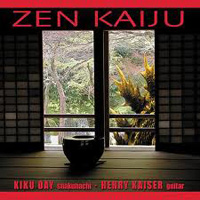
CLIVE BELL & BECHIR SAADE – An account of my hut. A review by Kiku Day
One would normally consider a CD of improvised music on the Japanese shakuhachi and the Arabian ney as an example of a ‘meeting’ of two distinct cultures. But not only are both instruments made of plants from the same grass family – the shakuhachi from bamboo and the ney from reeds – the sensitive exploration by the two fine improvisers, Clive Bell on shakuhachi and Bechir Saade on ney also shows that as well as differences, they have very much in common, not least with regard to timbre and musical language.
The key words for this CD are harmony and tranquillity. Thus the ‘meeting’ here is very smooth and without ‘clashes’, perhaps due to both musicians’ deep interest in improvisation and timbre. With his ney, Saade explores the links between Middle Eastern improvisation techniques and contemporary music, while Bell uses his shakuhachi to interpret traditional solo and ensemble music, folk songs, and improvisation. Both players move freely in and out of their instruments’ cultural backgrounds and their own interest in contemporary music.
In ‘Kindling’, the communication between the two players is peaceful, but powerful. They exchange phrases with each other, while at the same alluding to the music idiomatic to their respective instruments. Bell plays here a typical honkyoku phrase so slowly that its cultural provenance is disguised almost to the point of inaudibility. In ‘Straw’, the ney wails nostalgic phrases, which Bell layers beautifully, creating an ambiance of distant lands. In ‘An account of my hut’, they seem to synchronise their breathing and to be playing the other’s instrument (on their own, of course). And while improvised, this is a well-structured piece, in which the end possesses elements of the beginning. Both musicians have a wide palate of sounds and techniques and their exploration of multiphonics and timbre is remarkable, in particularly when they play with difference tones.
Simon Reynell, the owner of Another Timbre, a new and exciting UK CD label has done an admirable job of recording and mastering the music. Mic’ing is close and intense, and the listener gets the feeling that the two musicians are playing only a few arm-lengths away. The CDs hitherto released on this label seem carefully chosen and with a strong emphasis on improvisation. It will be worth keeping an eye on this label – as well as on Bell and Saade.
Kiku Day
(Originally written for ESS Newsletter, Issue 8 April, 2008)
Clive Bell & Bechir Saade – An account of my hut
Another Timbre CD at08 www.anothertimbre.com
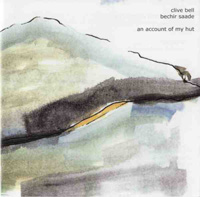
SABU ORIMO – Susabu and Ichion. A review by Clive Bell
Two solo albums on the tiny Japanese label Subjective Spirit Sound contain the most remarkable shakuhachi playing I’ve heard in years. Sabu Orimo is a player still in his twenties, with a fine lineage: both his parents were musicians in Punk groups. He studied shakuhachi with Atsuya Okuda and plays exclusively ji- nashi “hocchiku” flutes, large, natural bamboo with no lacquer or special treatment to affect the sound. His concert posters announce “Noise Shakuhachi Solo Live”, while his label describes him as playing “Japanese old stone age style”.
Susabu consists of nine pieces all recorded on 28th March 2006. The opener is a passionate treatment of the honkyoku “San-an”, full of busy flurries, gasps and violent stamping noises. It recalls the master Watazumido, but if anything is even more uninhibited and earthy. But Orimo’s control is firm –– he often swivels into silence, and the piece closes with great calm after the storm. A version of “Koku” is meditative and beautifully paced. Here you can clearly discern Okuda’s influence, and at seventeen minutes it’’s the same length as Okuda’s own recording.
Orimo also plays the honkyoku “Sanya” and “Honte No Shirabe”, but almost half of this album appears to be improvised. Susabu’s title track is in two parts, between which Orimo probably needed to lie down in a darkened room. “Susabu Part 1” is a full-blooded outburst, culminating in an almighty thump. In “Part 2” Orimo snorts down the flute like a trumpet, and roars as if possessed. The recording equipment reels under the onslaught – this is a demented howling you expect more on a lo-fi Punk record. It’s a shock, but somehow integrated into the story that Orimo is telling. His sound has such integrity that he can carry the listener with him; as with Albert Ayler’s saxophone, you feel that if he needs to extend his emotional range this wide, then so be it.
Susabu concludes with an extremely low-pitched and restrained track titled “Tsukiyo”. In spite of all this, it’s Ichion, Orimo’s second album, recorded two weeks later, that is one of my favourite records of 2006. Four of the five tracks are played on a long and low flute. Here what’s remarkable is how little Orimo does and how good his timing is. Three minutes can be devoted to exploration of one quiet note. The outside world creeps in around the edges: on “Yure” we can hear it’s pouring with rain. Five minutes in, Orimo makes his move. Gusts of wind whip through the bamboo, then he returns to stillness. These are extraordinary performances that seem to dig deep into Japanese tradition.
Clive Bell
(This review was originally written for The Wire magazine: www.thewire.co.uk)
Sabu Orimo – Susabu and Ichion
Susabo CD: Subjective Spirit Sound
Ichion CD: Subjective Spirit Sound


BRIAN TAIRAKU RITCHIE – Ryoanji. A review by Clive Bell
This is a shakuhachi record, but one with sweat on its brow and mud stains on its kimono. Bass player with Milwaukee alt-rockers Violent Femmes, Brian Ritchie was inspired to tackle a wind instrument after seeing Steve Lacy in New York. Eventually he hit on the Japanese Zen monk’s flute of choice and developed his own muscular, improvisational approach. His first release, Shakuhachi Club NYC from 2004 on Weed Records, pits Ritchie’s flute against banjo, tuba and drums (Billy Ficca from Television). Ritchie blasts away as if on trombone, but the context is so raucous it almost overwhelms what is essentially a delicate instrument.
Ryoanji, while still unpolished in the best sense, is a step forward. Ritchie’s own playing is stronger and more focused, and his current band make a dark and appropriate sound: Dave Gelting on string bass and John Sparrow on gongs and cajon (the Afro-Peruvian wooden box also used in flamenco). Ritchie takes Japanese folk songs and treats them as stomping jazz vehicles for group exploration. Classic shakuhachi “honkyoku” pieces are enlisted as drifting melodies, played unison with bowed bass and coloured by tympani. Popular melody “Kojo No Tsuki” leads to freeblowing in the manner of Ayler and Coltrane, and there’s a Steve Lacy lament for a Japanese friend that plays well as a thoughtful, downbeat blues.
At the album’s centre is “Ryoanji”, a fourteen minute version of a late John Cage piece inspired by the Zen rock garden. Shakuhachi and bass glide around eerie glissandi while the percussionist thumps an irregular pulse. It’s a stirring performance: definitely Cage with jacket and tie off, and immediately followed by “Soran Bushi”, a riotous drinking song.
Clive Bell
(This review was originally written for The Wire magazine: www.thewire.co.uk)
Brian Tairaku Ritchie – Ryoanji
THYLACINE CD

